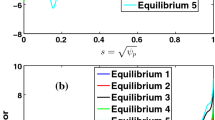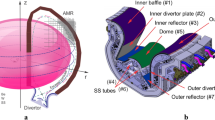Abstract
Quasi-snowflake-plus (QSF+) and the lower single null diverted (SND) magnetic equilibria have been proposed as the promising designs for the Chinese fusion engineering testing reactor (CFETR). The impact of these two candidate magnetic equilibria on the H-mode stationary plasma heat flux deposition onto the first wall has been assessed. Comparing the distributions of plasma heat flux on the CFETR first wall for QSF + and SND indicates that the SND is more beneficial for the engineering design of the first wall module, since the computational results prove that there is only one module of the first wall being recognized as the enhanced heat flux module (EHFM) in the case of SND. Meanwhile, due to the SND magnetic equilibrium is the baseline configuration used in the CFETR design work and \(\varDelta {R}_{\text{s}\text{e}\text{p}}\)is an important factor for plasma control system (PCS) during the tokamak operation, the impact of SND magnetic equilibria with a series of \(\varDelta {R}_{\text{s}\text{e}\text{p}}\) on the plasma heat flux deposition onto the first wall is further studied. Comparing the peak plasma heat flux on the CFETR first wall for SND with varying \(\varDelta {R}_{\text{s}\text{e}\text{p}}\) builds more confidences in using \(\varDelta {R}_{\text{s}\text{e}\text{p}}\)= 6 cm as the baseline SND equilibrium in the CFETR design work, where the plasma heat flux on the first wall is close to current engineering constraints of 1 MW/m2. With the baseline SND equilibrium design, the sensitivity of plasma heat flux to power decay length will not be a priority for the safety of the first wall.









Similar content being viewed by others
Availability of data and materials
The datasets generated during and/ or analyzed during the current study are available from the corresponding author on reasonable request.
References
Y.X. Wan, J.G. Li, Y. Liu et al., Nucl. Fusion 57(10), 102009 (2017)
G. Zhuang, G.Q. Li, J. Li et al., Nucl. Fusion 59(11), 112010 (2019)
R. Wenninger, R. Albanese, R. Ambrosino et al., Nucl. Fusion 57(4), 046002 (2017)
F. Nian, Z. Yang, R. Ding et al., Plasma Phys. Control Fusion 63(9), 095004 (2021)
S. Liu, X. Li, X. Ma et al., Fusion Eng. Des. 146, 1716–1720 (2019)
F. Maviglia, M. Siccinio, C. Bachmann et al., Nucl. Mater. Energy 26, 100897 (2021)
K.C. Jiang, E. Martelli, P. Agostini et al., Fusion Eng. Des. 146, 2748–2756 (2019)
R. Wenninger, R. Kembleton, C. Bachmann et al., Nucl. Fusion 57(1), 016011 (2017)
J. Linke, J. Du, T. Loewenhoff et al., Matter and Radiation at Extremes 4(5), 056201 (2019)
H. Li, G.Q. Li, X.J. Liu et al., Fusion Eng. Des. 152, 111447 (2020)
M. Kotschenreuther, P.M. Valanju, S.M. Mahajan et al., Phys. Plasmas 14(7), 072502 (2007)
S.F. Mao, Y. Guo, X.B. Peng et al., J. Nucl. Mater. 463, 1233–1237 (2015)
X.J. Liu, G.Q. Li, D. Zhao et al., IEEE Trans. Plasma Sci. 46(5), 1377–1381 (2018)
Y.F. Zhou, S.F. Mao, N. Shi et al., Fusion Eng. Des. 136, 931–935 (2018)
X.J. Liu, G.L. Xu, R. Ding et al., Phys. Plasmas 27(9), 092508 (2020)
T. Petrie, J. Watkins, L. Baylor et al., J. Nucl. Mater. 313–316 (2003) 834–838
R.A. Pitts, S. Carpentier, F. Escourbiac et al., J. Nucl. Mater. 415(1), S957–S964 (2011)
F. Maviglia, G. Federici, R. Wenninger et al., Fusion Eng. Des. 124, 385–390 (2017)
M. Firdaouss, V. Riccardo, V. Martin et al., J. Nucl. Mater. 438, S536–S539 (2013)
M. Firdaouss, T. Batal, J. Bucalossi et al., Fusion Eng. Des. 98–99 (2015) 1294–1298
B. Zhang, M. Firdaouss, X. Gong et al., Fusion Eng. Des. 107, 58–63 (2016)
A. Loarte, B. Lipschultz, A.S. Kukushkin et al., Nucl. Fusion 47(6), S203–S263 (2007)
D. Carralero, P. Manz, L. Aho-Mantila et al., Phys. Rev. Lett. 115(21), 215002 (2015)
S. Pestchanyi, IEEE Trans. Plasma Sci. 46(5), 1393–1397 (2018)
T. Eich, A.W. Leonard, R.A. Pitts et al., Nucl. Fusion 53(9), 093031 (2013)
R.J. Goldston, Nucl. Fusion 52(1), 013009 (2012)
X.Q. Xu, N.M. Li, Z.Y. Li et al., Nucl. Fusion 59(12) (2019)
C.S. Chang, S. Ku, R. Hager et al., Phys. Plasmas 28(2) (2021)
R. Mitteau, A. Moal, J. Schlosser et al., J. Nucl. Mater. 266(1), 798–803 (1999)
F. Militello, J.T. Omotani, Plasma Phys. Control Fusion 58(12), 125004 (2016)
Y. Miyoshi, R. Hiwatari, Y. Someya et al., Fusion Eng. Des. 151, 111394 (2020)
M. Brank, R.A. Pitts, G. Simič et al., Nucl. Mater. Energy 27, 101021 (2021)
D. Carralero, S. Artene, M. Bernert et al., Nucl. Fusion 58(9), 096015 (2018)
D. Carralero, M. Siccinio, M. Komm et al., Nucl. Fusion 57(5), 056044 (2017)
X. Bonnin, W. Dekeyser, R. Pitts et al., Plasma Fusion Res. 11(0), 1403102–1403102 (2016)
K. Tobita, K. Tani, Y. Kusama et al., Nucl. Fusion 35(12), 1585–1591 (1995)
S. Liu, X. Cheng, X. Ma et al., Theor. App Mech. Lett. 9(3), 161–172 (2019)
R. Mitteau, P. Stangeby, H. Labidi et al., J. Nucl. Mater. 463, 411–414 (2015)
Z. Vizvary, W. Arter, T.R. Barrett et al., Fusion Eng. Des. 146, 2577–2580 (2019)
S.H. Kim, J.F. Artaud, V. Basiuk et al., Plasma Phys. Control. Fusion 51(10) (2009)
P.C. Stangeby, The Plasma Boundary of Magnetic Fusion Devices (CRC Press, 2000)
J.A. Crotinger, L. LoDestro, L.D. Pearlstein et al., Office of Scientific & Technical Information Technical Reports, 1997
R. Wenninger, F. Arbeiter, J. Aubert et al., Nucl. Fusion 55(6), 063003 (2015)
D.A. D’Ippolito, J.R. Myra, S.I. Krasheninnikov, Phys. Plasmas 9(1), 222–233 (2002)
M. Greenwald, D. Andelin, N. Basse et al., Nucl. Fusion 45(10), S109–S117 (2005)
R.A. Pitts, in: 10th ITER International School, KAIST, Daejeon, South Korea, 2019
H. Anand, R.A. Pitts, P.C. De Vries et al., Nucl. Fusion 60(3), 036011 (2020)
Acknowledgments
The authors wish to thank the CFETR task team 1 for their great suggestions and help.
Funding
This work was supported by the National Key Research & Development Program of China under Contracts Nos. 2018YFE0303103, National Natural Science Foundation of China under Contract Nos. 11875287, 11705233, 12022511, 11861131010, and the Key Research Program of Frontier Sciences, CAS with Grant No. ZDBS-LYSLH010.
Author information
Authors and Affiliations
Contributions
F.N.: Conceptualization, methodology, validation, formal analysis, investigation, writing - original draft, writing - review & editing.
Z.Y.: conceptualization, methodology, validation, formal analysis, investigation, supervision, project administration, funding acquisition. H.L: conceptualization, methodology, validation, formal analysis, sources, data curation. R.D: conceptualization, methodology, validation, writing - review & editing, funding acquisition. G.N.: writing - review & editing, validation, funding acquisition. B.Z: sources, validation, software. R.W: writing - review & editing, validation, visualization. K.L.: writing - review & editing, data curation. T.H.: resources, validation. S.P.: resources, validation. G.L.: project administration.
Corresponding author
Ethics declarations
Ethical Approval
It is not applicable.
Competing interests
The authors declare no competing interests.
Additional information
Publisher’s Note
Springer Nature remains neutral with regard to jurisdictional claims in published maps and institutional affiliations.
Rights and permissions
Springer Nature or its licensor (e.g. a society or other partner) holds exclusive rights to this article under a publishing agreement with the author(s) or other rightsholder(s); author self-archiving of the accepted manuscript version of this article is solely governed by the terms of such publishing agreement and applicable law.
About this article
Cite this article
Nian, F., Yang, Z., Li, H. et al. Assessment of the Impact of Magnetic Equilibria Designs on the Stationary Plasma Heat Flux Deposition onto the CFETR First Wall. J Fusion Energ 42, 2 (2023). https://doi.org/10.1007/s10894-022-00340-w
Accepted:
Published:
DOI: https://doi.org/10.1007/s10894-022-00340-w




